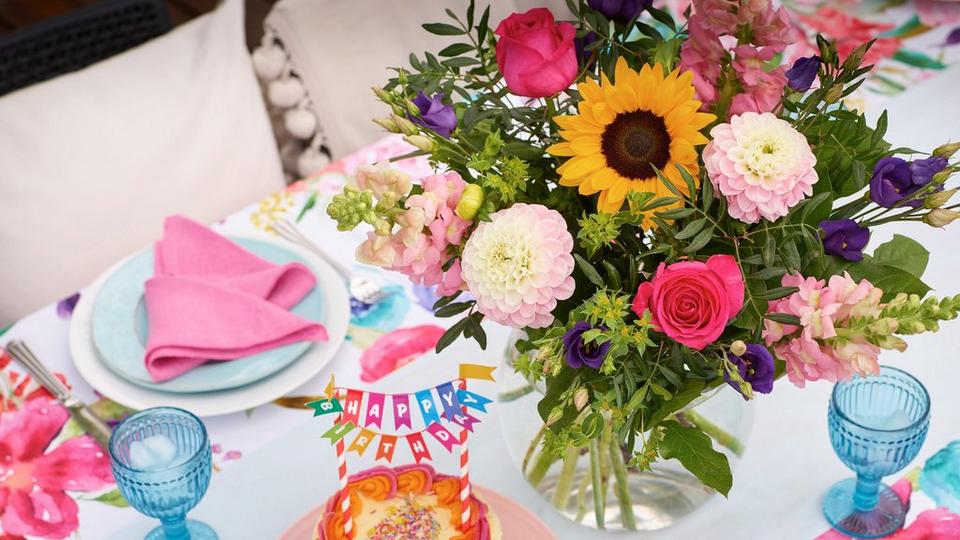Discover Your Birth Flower

January: Carnation
February: Violet
March: Daffodil (Narcissus)
April: Daisy
May: Lily of the Valley
June: Rose
July: Delphinium
August: Gladiolus
September: Aster
October: Marigold
November: Chrysanthemum
December: Holly
Birth Flower Meanings Through the Seasons
Each birth flower has its own ties to specific qualities or virtues. Whether it’s the optimism of the daffodil or the strength of the gladiolus, flowers serve as a reflection of personality traits or symbolic messages for those born in each month.
As well as the the monthly symbolism, seasonal blooms offer another layer of meaning:
- Winter (December to February) flowers like the holly and snowdrop symbolise hope and renewal, perfect for those colder, more reflective months.
- Spring (March to May) flowers like the daffodil and Lily of the Valley bring a sense of fresh beginnings and optimism.
- Summer (June to August) flowers such as the rose and larkspur represent passion, strength, and joy.
- Autumn (September to November) flowers, including the chrysanthemum and marigold, signify wisdom, perseverance, and joy.
Birth Flowers vs. Zodiac Flowers: What’s the Difference?
Birth flowers and zodiac flowers both carry symbolic meaning, but they are rooted in different traditions. Birth flowers are specially linked to the month of your birth, and are traditionally associated with certain qualities and traits of individuals born in that month. Zodiac flowers, on the other hand, are tied to your astrological sign and are based on the position of the stars and planets at the time of your birth.
While zodiac flowers can reflect your personality traits according to astrology, birth flowers are unique because they are linked to the natural cycle of the year, allowing them to represent the changing seasons, renewal, and growth. Birth flowers provide a timeless, seasonal connection, while zodiac flowers offer a more astrological connection.
Ultimately, both types of flowers can have deep meaning, but birth flowers allow you to celebrate someone’s birthday in a more seasonal and personal way.
Personalising Gifts with Birth Flowers
Using birth flowers to create bespoke bouquets or arrangements can transform a simple gift into something deeply meaningful. A bouquet of violets for a February birthday expresses faithfulness and modesty, while a chrysanthemum for November conveys friendship and well-wishing. Incorporating these flowers into birthday bouquets or celebrations makes your gesture even more thoughtful and memorable.
At Interflora, we believe in creating connections through the beauty of flowers. With our hand-crafted arrangements, expert florists, and the deep symbolism behind birth flowers, your gift will always feel personal, meaningful, and filled with love.
Birth Flower FAQs
Yes! Birth flowers are versatile and can be gifted for plenty of occasions beyond birthdays. They are perfect for celebrating anniversaries, new babies, and even graduations.
You can use someone’s birth flower to add a personal touch to any special day, making their gift all the more meaningful.
While birth flowers are largely the same across countries, there can be slight regional differences. For example, in the USA, the birth flower for July is the larkspur, while in the UK, it is often delphinium.
However, the meanings and symbolism remain relatively consistent, and each country has its own unique list to honour local traditions and choose the most seasonally available flower.
Absolutely! Combining birth flowers from different months can create a beautiful bouquet that’s just as meaningful. It’s an excellent idea for family bouquets, or for couples who want to celebrate both partners’ birthdays at once.
You could even create an arrangement based on your family’s heritage, where each flower represents a different family member.
Yes, of course! At Interflora, we understand that not everyone connects with their birth flower. You can always opt for another bouquet instead, simply choosing flowers you like or which feel significant to you.
To make sure your birth flower bouquet stays beautiful, here are some simple care tips:
- Trim the stems regularly to keep them hydrated.
- Place the bouquet in a clean vase with fresh water and flower food.
- Keep flowers away from direct sunlight and heat sources.
- Change the water every couple of days to prolong freshness.
For more information on how to keep any bouquet looking beautiful for longer, read our expert guide to caring for cut flowers.
Yes! When ordering from Interflora, you’ll have the option to add a personalised message with any flower bouquet. Whether it’s a short and sweet note or a heartfelt message, you can express your feelings in a way that makes the gift even more special.
Handwritten cards and thoughtful birthday messages can make all the difference when sending flowers for someone’s special day.
Birth flowers are deeply rooted in British tradition, with many associating particular flowers with local festivals or seasonal celebrations. For example, the daffodil is a symbol of St David’s Day in Wales, and chrysanthemums are seen as meaningful in the UK as a flower of friendship.
The custom of using birth flowers as personalised gifts is growing more and more popular, making them a common feature at many British celebrations.

.jpg?$poi-square$&fmt=auto&qlt=default&fmt.jp2.qlt=60&bg=%23FECCA7&w=960&aspect=16%3A9)

.jpg?$poi-square$&fmt=auto&qlt=default&fmt.jp2.qlt=60&bg=%23FFCBDB&w=960&aspect=16%3A9)